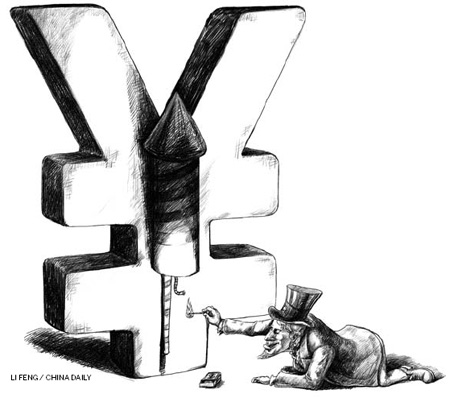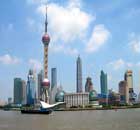Op-Ed Contributors
Alternatives to revaluating the yuan
By Xiao Geng (China Daily)
Updated: 2010-03-25 07:48
 |
Large Medium Small |
Editor's note: According to the author, it’s not the appropriate time to revaluate yuan in consideration of national interests of both US and China. But he suggests some structural and institutional reforms as alternative options.
The debate on how to correct the trade imbalance between the United States and China is focused on increase: How to increase US exports and savings and how to increase Chinese imports and consumption.
A big part of the debate, especially in the US, is focused on China's currency, which US leaders allege is undervalued. The Americans want China to revalue the yuan considerably in the hope that it would lead to an increase in US exports and employment.
Chinese leaders differ. They regard the US pressure to revaluate the yuan and Washington's protectionist measures as unfair and detrimental to China's development. They place emphasis upon structural and institutional reform to increase Chinese consumption and make domestic investment more efficient.
| ||||
The US demand for the revaluation of the yuan is based upon its short-term concern over China's large current account surplus and long-term worry over China's high growth, rapid urbanization and industrialization, low national debt and low fiscal deficits.
China, on its part, is worried that a revaluated yuan or a premature end to its link with the US dollar would cause financial instability through speculative capital inflow, asset bubbles and nominal shocks to employment and business in its exports sector. China fears that a currency revaluation could destabilize capital inflows and discourage private Chinese firms and financial institutions from buying dollar assets, especially if their values could continually to fall in yuan terms.
Beijing has not forgotten how the large increase in the value of the Japanese yen brought about by the 1985 Plaza Accord created massive asset bubbles, which burst in 1989 and led to a two decade-long deflation without eliminating Japan's trade surplus.
But a nominal exchange rate adjustment is not China's only tool for correcting trade imbalances. If China pegs the yuan to the dollar, it can still use inflation to achieve a rapid increase in its price level relative to that in the US, or a real revaluation of the yuan against the dollar. Relative price levels between economies tend to take into account the nominal exchange rate and adjust price levels for the gap in inflation rates between two economies.
Because of these two factors the Chinese approach to exchange rate stability thus far has focused on inflation first and appreciation second. This puts priority on creating employment, increasing wages and productivity, and price liberalization rather than addressing trade imbalances through adjustments of the nominal exchange rate.
Given that the Chinese approach is likely to remain constant, it is important to consider some alternative policy options, particularly certain structural and institutional reforms.
First, to reduce savings and inefficient investment, China needs to privatize and deregulate large State-owned enterprises (SOEs). China's savings rate reached the high of about 55 percent of GDP in 2007-2008, with a current account surplus of about 10 percent of GDP. Corporate savings amount to about half of the national savings, and a major contributing factor is the savings of China's SOEs.
The SOEs are not allowed to pay high salaries to their employees and do not distribute dividends, and they do not generate purchasing power when the prices of their shares increase. This has created huge capital gains with no wealth effects on consumption. In addition, the high-savings of SOEs are often invested in overcapacity sectors.
Household income still accounts for only 35 percent of China's national income, and the country will not be able to significantly raise the wages and productivity of its workforce in the near future. To improve domestic consumption, therefore, China must create an investment environment conducive to investment in sectors with large domestic consumption potential. In sum, investment at present is the most important variable for eliminating China's current account surplus, and for absorbing its savings internally.
Especially now, it is important that investments be made more efficiently. In the past few years cheap money, or a low interest rate, has often led to inefficient investment in China's exports manufacturing sector, driving down prices of "made in China" products. Since the US' current zero interest rate policy is likely to bring capital flows into China in the hope of higher investment return, the current availability of cheap money is likely to continue. Because of this it is important that China improve its capital control mechanisms to allow orderly cross-border capital flows for more efficient investments with higher returns both domestically and internationally, while limiting the speculative flow of capital and inefficient investments.
Another overlooked problem contributing to the global imbalance is factor price distortion in the Chinese economy. This must be addressed if the global economy is to be righted. Price distortions are caused by a number of factors, including local governments' offering of cheap land as part of efforts to attract foreign invested enterprises, weak property rights, rudimentary carbon-emission standards, weak enforcement of environmental protection laws, and a lack of a social safety net, which makes the cost of labor low now, but has hidden social liabilities for the future.
Given the huge potential of cross-border investment and debt financing between the US and China, a stable yuan-dollar exchange rate suits both countries' long-term national interests. And in the long-term, certainly after 2020 and perhaps between 2025 and 2035, the yuan is likely to become a fully convertible currency. But for that to happen, the Chinese economy must first complete its structural and institutional transformation into a fully modernized market economy with a more democratic political system. Until then, the US and China should look for long-term policy options that are realistic and beneficial to both countries.
The author is director of the Brookings-Tsinghua Center for Public Policy in Beijing and senior fellow of the Brookings Institution in Washington DC.

(China Daily 03/25/2010 page9)












